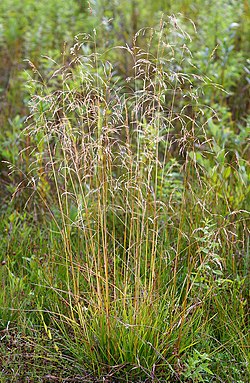| Deschampsia cespitosa | |
|---|---|
 | |
| Scientific classification | |
| Kingdom: | Plantae |
| Clade: | Tracheophytes |
| Clade: | Angiosperms |
| Clade: | Monocots |
| Clade: | Commelinids |
| Order: | Poales |
| Family: | Poaceae |
| Subfamily: | Pooideae |
| Genus: | Deschampsia |
| Species: | D. cespitosa |
| Binomial name | |
| Deschampsia cespitosa | |
| Synonyms | |
Deschampsia caespitosa | |
Deschampsia cespitosa, commonly known as tufted hairgrass or tussock grass, [1] is a perennial tufted plant in the grass family Poaceae. [2] The distribution of this species is widespread, with it being native to North America, Central Africa, eastern Australia and Eurasia and being introduced to South Africa, South Australia and South America.

